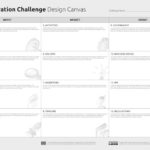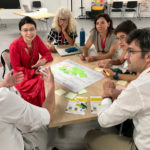Innovation Challenges
The Trentino Innovation Hub Foundation (HIT), aims to promote and enhance the scientific-technological research activities of its founders: University of Trento, Edmund Mach Foundation, Bruno Kessler Foundation and Trentino Sviluppo.
An important element of this are the Innovation Challenges that HIT organises to enable companies to source knowledge and solutions to innovation problems. This is achieved by companies engaging with young talents and experts outside the immediate organisation, according to the Open Innovation paradigm.
Nicola Doppio, Innovation Officer at HIT, ran a workshop at the R&D Management Conference 2022 and discussed some of the learning points that the organisation has gained from running these challenges. We asked him to share his experiences with R&D Today.

What is an Innovation Challenge?
Innovation Challenges can be organized by intermediaries (such as HIT) that have strong innovation management expertise and the capacity to engage with both companies and potential problem “solvers” (e.g university students). The idea is to team up to develop tangible solutions, not only ideas or concepts, but product prototypes in a relatively short term such as a week to three months.
Some good examples of Open Innovation Challenges are those run by by my organisation HIT – Hub Innovazione Trentino: a public foundation whose mission is to foster technology and knowledge transfer in the Trentino province (Italy). These include:
The UX Challenge – a 5-day Design Sprint contest during which experts in human-computer interaction test and redesign the user experience of digital products and services presented by companies. Outputs are tangible interface prototypes tested with end-users.
Industrial AI Challenge – a 10-week Challenge that allows manufacturing companies to collaborate with teams of students with a background in data science, industrial engineering and mathematics to delve into existing datasets. The aim is to develop deep-learning-based models for optimizing and predicting crucial events in industrial operations such as predictive maintenance, production planning optimization, automated quality control.
What type of outcomes do the Innovation Challenges have?
Innovation Challenges spark a wide array of positive impacts for all participants:
Companies – they can source demos and prototypes of new or improved product features or enabling technologies. They also do talent scouting, as often challenges result in hiring talents, or initiating internships or research theses to progress the findings.
University students (MSc or PhD) – students spend a significant time in a teamwork setting, this stimulates the development of entrepreneurial and problem solving skills and many soft skills such as teamwork, decision making, communication, negotiation.
University staff – challenges provide an opportunity for teachers to implement CBL – Challenge-Based Learning in own master and PhD courses, enhancing the quality of education. Principal investigators (PI) can widen their network with companies to develop R&D and innovation projects starting from the results of the challenges. Young researchers can build team management and innovation management skills by mentoring teams of solvers. Tech Transfer Office (TTO) staff can see opportunities for their tech transfer deal flow in case IP is generated within the Challenge.
Regional Innovation Ecosystems (RIEs) – Innovation Challenges build trust and project-based collaboration opportunities among all participants (companies, HEIs, intermediary innovation agencies, citizens – in case they are involved as solution testers and validators). This can break down the barriers that normally prevent academic institutions collaborating with companies, especially SMEs.
What is the INNOCHALLENGE and how does this tool support challenges?
In recent years the European Commission has been consistently supporting the experimentation and adoption of Innovation Challenges across Europe.
For example, The EU funded H2020 CSA INNOSUP-05 project “INNOCHALLENGE”, has been aimed at exchanging good practices of Innovation Challenges between innovation agencies. It delivered a collection of good practices (available at www.innochallenge-project.eu) to inspire future pilots.
The INNOCHALLENGE project also developed a Visual Guide, based on a Canvas tool, that can be used by practitioners to design Innovation Challenges tailored to needs and requirements of specific companies, industry clusters, or regional ecosystems.
In particular, the Guide points out what are the main parameters (or “building blocks”) that needs to be addressed when designing an Open Innovation Challenge:
- Who are the solvers
- What are the right incentives
- Who will own the IPR – Intellectual Property Rights emerging from the results
How did the workshop at the R&D Management Conference 2022 go?
The Innovation Challenge Design Canvas was the main topic of a workshop hosted by myself, Nicola Doppio, Innovation Officer at Hub Innovazione Trentino, and Charlotte Norrman, professor of Innovation Management at Linköping University.
In order to learn how to use the canvas in practice, participants were challenged with the task of using it for designing a dummy innovation contest format, aiming at contributing to the achievement of SDG (related to sustainable cities and communities).
Teams presented their own challenge designs, which sparked a fruitful and engaging conversation.
The workshop was sponsored by the European project Boogie-U, funded by EIT – European Institute of Technology with the aim to accelerate the adoption of CBL – Challenge-Based Learning in universities (eit-hei.eu/projects/boogie-u).
For more information about these topics, and for collaboration opportunities, please contact Nicola Doppio.
Suggested reading
- Doppio, N., Mion, L., Väinämö, S., Purga, K., & Koskiniemi, P. (2018). INNOVATION CHALLENGES! A practical guide to design initiatives to support Open Innovation in SMEs, innochallenge-project.eu
- Doppio, N., Väinämö, S., Haukipuro, L., (2020). Design elements of innovation contests suppor-ting Open Innovation in SMEs – An action research study, Journal of Innovation Management, www.open-jim.org,8(4), 26-56.
- Liotard, I., & Revest, V. (2018). Contests as innovation policy instruments: Lessons from the US federal agencies’ experience. Technological Forecasting and Social Change, 127(March 2016), 57–69.
- (2014). Challenge Prizes: A Practice Guide. https://www.nesta.org.uk/sites/default/files/challenge-prizes-design-practice-guide.pdf
- Brown, M., Nic Giolla Mhichíl, M., Mac Lochlainn, C., Pirkkalainen, H., & Wessels, O. (2021). Paving the Road for the Micro-Credentials Movement – ECIU University White Paper on Micro-Credentials.

Nicola Doppio works as Innovation officer at HIT – Hub Innovazione Trentino (Italy). He has a 10-year experience in leading projects and actions supporting research-industry technology transfer and open innovation at a regional and European level. Since 2016 he has fostered open innovation in 60+ companies, most of which SMEs – Small and Medium Enterprises; he also coordinated 5 EU projects (H2020 and EIT KICs) in the realm of open innovation and tech transfer capacity building in SMEs and academia. Besides that, Nicola coaches researchers and startups on topics such as user-centered design, design thinking, product innovation, lean start-up. Nicola holds a master’s degree in Sociology and an EMIM – Executive Master in Management from MIP – Politecnico di Milano Graduate School of Business.
See Nicola’s profile on trentinoinnovation.eu
Follow Nicola on LinkedIn and Twitter.
Visit the InnoChallenge website and the Trento Innovation Hub website.



